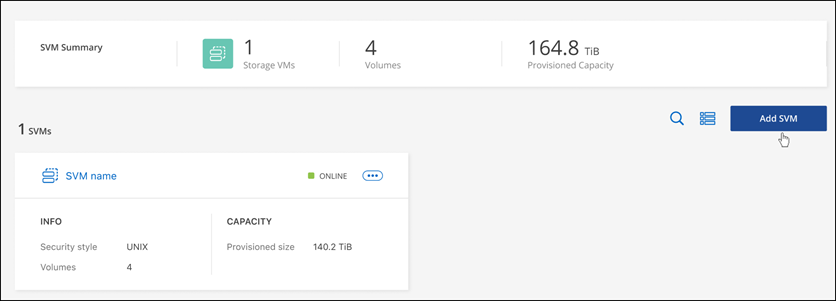Add and manage storage VMs for FSx for ONTAP
 Suggest changes
Suggest changes


After you create your working environment, you can add, view, and manage a storage virtual machine (VM)--also referred to as an SVM--on a managed FSx for ONTAP cluster.
Add a storage VM
Using BlueXP, you can add storage VMs to the FSx for ONTAP file system up to the maximum number allowed. Refer to AWS: Managing FSx for ONTAP storage virtual machines for details.
You can add a storage VM by opening the working environment and selecting the Storage VMs tab or from the working environment Overview panel. This task describes adding a storage VM using the Storage VMs panel.
-
You need an active Connector in AWS.
-
Create one or more storage VMs. Refer to Manage storage VMs in BlueXP for details.
-
Select the FSx for ONTAP working environment on the Canvas. If you don't have a Connector enabled, you'll be prompted to add one.
-
Select the Storage VMs panel. Existing SVMs are displayed. Select Add SVM to add a new SVM.

-
Add storage virtual machine
-
Enter the name of your storage VM.
-
Select the configured storage VM root volume security style. Valid values are UNIX, NTFS, or Mixed.
-
Optionally, specify a storage VM administrative password.
-
Optionally, create up to fifty tags to categorize your SVM by clicking the plus sign and entering a tag name and value.
-
Select Add to add the storage VM.
-
The new storage VM is added to the working environment and the FSx for ONTAP file system.
Manage a storage VM
You can view storage VM details, manage tags, set up an SMB/CIFS connection, or delete a storage SVM.
You need an active Connector in AWS.
-
Select the FSx for ONTAP working environment on the Canvas. If you don't have a Connector enabled, you'll be prompted to add one.
-
Select the Storage VMs panel.
-
Use the three dots (
 ) to open the options menu for the storage VM.
) to open the options menu for the storage VM.
-
Select a menu option to view or manage the storage VM settings.
-
View SVM details: You can review details including root volume, security style, allowed protocols, Active Directory domain, and tags.
-
Manage SVM tags: You can add, edit, or remove storage VM tags. Changes you make will sync with the AWS Management Console.
-
Set up SMB/CIFS: If this is the first CIFS connection for this working environment, you will be prompted to configure CIFS connectivity using an Active Directory or Workgroup setup.
-
If you select a Workgroup setup, enter the server and workgroup name for a workgroup configured for CIFS.
-
If you select an Active Directory setup, you'll need to provide the following configuration information.
Active Directory configuration
Field Description DNS Primary IP Address
The IP addresses of the DNS servers that provides name resolution for the CIFS server.
The listed DNS server must contain the service location records (SRV) needed to locate the Active Directory LDAP servers and domain controllers for the domain the CIFS server will join.Active Directory Domain to join
The FQDN of the Active Directory (AD) domain you want the CIFS server to join.
Credentials authorized to join the domain
The name and password of a Windows account with sufficient privileges to add computers to the specified Organizational Unit (OU) within the AD domain.
CIFS server NetBIOS name
A CIFS server name that is unique in the AD domain.
Organizational Unit
The organizational unit within the AD domain to associate with the CIFS server. The default is CN=Computers.
DNS Domain
The DNS domain for the storage virtual machine (SVM). In most cases, the domain is the same as the AD domain.
NTP Server
Select Enable NTP Server Configuration to configure an NTP server using the Active Directory DNS. If you need to configure an NTP server using a different address, then you should use the API. See the BlueXP automation docs for details.
-
-
Delete SVM: You can delete the storage VM. You must verify the storage VM name to delete it.
You must delete all volumes on the storage VM before deleting the storage VM.
-



 Get started
Get started
